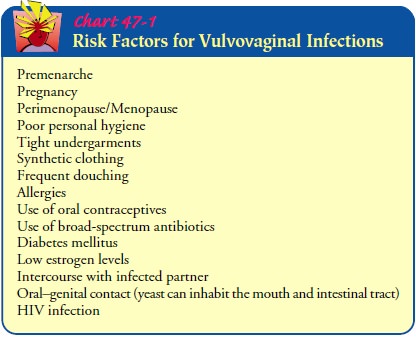Chapter: Medical Surgical Nursing: Management of Patients With Female Reproductive Disorders
Vulvovaginal Infections
Vulvovaginal Infections
The
vagina is protected against infection by its normally low pH (3.5 to 4.5),
which is maintained in part by the actions of Lactobacillus acidophilus, the
dominant bacteria in a healthy vaginal ecosystem. These bacteria suppress the
growth of anaerobes and produce lactic acid, which maintains normal pH. They
also produce hydrogen peroxide, which is toxic to anaerobes. The risk of
infection rises if a woman’s resistance is reduced by stress or illness, if the
pH is altered, or if a pathogen is introduced.
Vulvovaginal
infections are common problems, and nurses have an important role in providing
information that may prevent theiroccurrence. To prevent these infections,
women need to understand their own anatomy and vulvovaginal hygiene measures.
In addition, continued research into causes and treatments is needed, along
with better ways to encourage growth of lactobacilli.
The
epithelium of the vagina is highly responsive to estrogen, which induces
glycogen formation. The subsequent breakdown of glycogen into lactic acid
assists in producing a low vaginal pH.When estrogen decreases during lactation
and menopause, glycogen also decreases. With reduced glycogen formation,
infections may occur. In addition, as estrogen production ceases during the
perimenopausal and postmenopausal periods, the vagina and labia may atrophy
(thin), making the vaginal area more susceptible to infection. When patients
are treated with antibiotics, the norma vaginal flora are reduced. This results
in altered pH and growth of fungal organisms. Other factors that may initiate
infections include sexual intercourse with an infected partner and wearing
tight, nonabsorbent, and heat-retaining clothing (Chart 47-1).

Vaginitis (inflammation of the vagina) occurs when Candida or Trichomonas species or other bacteria invade the vagina. The normal vaginal discharge, which may occur in slight amounts during ovulation or just before the onset of menstruation, becomes more profuse when vaginitis occurs. Urethritis may accompany vaginitis because of the proximity of the urethra to the vagina.
Dis-charge that occurs
with vaginitis may produce itching, odor, red-ness, burning, or edema, which
may be aggravated by voiding and defecation. After the causative organism has
been identified, ap-propriate treatment (discussed later) is prescribed. This
may in-clude oral medication or local medication that may be inserted into the
vagina using an applicator.
Related Topics